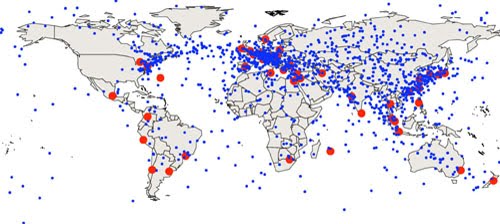 |
| Off switch: This visualization shows network traffic when traffic loads are low and switches (the large dots) can be turned off to save power. Credit: Open Flow Project |
Most data networks could be faster, more energy efficient, and more secure. But network hardware—switches, routers, and other devices—is essentially locked down, meaning network operators can't change the way they function. Software called OpenFlow, developed at Stanford University and the University of California, Berkeley, has opened some network hardware, allowing researchers to reprogram devices to perform new tricks.
Now 23 companies, including Google, Facebook, Cisco, and Verizon, have formed the Open Networking Foundation (ONF) with the intention of making open and programmable networks mainstream. The foundation aims to put OpenFlow and similar software into more hardware, establish standards that let different devices communicate, and let programmers write software for networks as they would for computers or smart phones.
"I think this is a true opportunity to take the Internet to a new level where applications are connected directly to the network," says Paul McNab, vice president of data center switching and services at Cisco.
Computer networks may not be as tangible as phones or computers, but they're crucial: cable television, Wi-Fi, mobile phones, Internet hosting, Web search, corporate e-mail, and banking all rely on the smooth operation of such networks. Applications that run on the type of programmable networks that the ONF envisions could stream HD video more smoothly, provide more reliable cellular service, reduce energy consumption in data centers, or even remotely clean computers of viruses.
The problem with today's networks, explains Nick McKeown, a professor of electrical engineering and computer sciences at Stanford who helped develop OpenFlow, is that data flows through them inefficiently. As data travels through a standard network, its path is determined by the switches it passes through, says McKeown. "It's a little bit like a navigation system [in a car] trying to figure out what the map looks like at the same time it's trying to find you directions," McKeown explains.
With a programmable network, he says, software can collect information about the network as a whole, so data travels more efficiently. A more complete view of a network, explains Scott Shenker, professor of electrical engineering and computer science at the University of California, Berkeley, is a product of two things: the first is OpenFlow firmware (software embedded in hardware) that taps into the switches and routers to read the state of the hardware and to direct traffic; the second is a network operating system that creates a network map and chooses the most efficient route.
OpenFlow and a network operating system "provide a consistent view of the network and do that at once for many applications," says McKeown. "It becomes trivial to find new paths."
Some OpenFlow research projects require just a couple hundred lines of code to completely change the data traffic patterns in a network—with dramatic results. In one project, McKeown says, researchers reduced a data center's energy consumption by 60 percent simply by rerouting network traffic within the center and turning off switches when they weren't in use.
This sort of research has caught the attention of big companies, and is one reason why the ONF was formed. Google is interested in speeding up the networks that connect its data centers. These data centers generally communicate through specified paths, but if a route fails, traffic needs to be rerouted, says Urs Hoelzle, senior vice president of operations at Google. Using standard routing instructions, this process can take 20 minutes. If Google had more control over how the data flowed, it could reroute within seconds, Hoelzle says.
Cisco, a company that builds the hardware that routes much of the data on the Internet, sees ONF as a way to help customers build better Internet services. Facebook, for example, relies on Cisco hardware to serve up status updates, messages, pictures, and video to hundreds of millions of people worldwide. "You can imagine the flood of data," says McNab.
Future ONF standards could let people program a network to get different kinds of performance when needed, says McNab. Building that sort of functionality into Cisco hardware could make it more appealing to Internet services that need to be fast.
The first goal of the ONF is to take over the specifications of OpenFlow, says McKeown. As a research project, OpenFlow has found success on more than a dozen campuses, but it needs to be modified so it can work well at various companies. The next step is to develop easy-to-use interfaces that let people program networks just as they would program a computer or smart phone. "This is a very big step for the ONF," he says, because it could increase the adoption of standards and speed up innovation for network applications. He says the process could take two years.
In the meantime, companies including Google, Cisco, and others will test open networking protocols on their internal networks—in essence, they'll be testing out a completely new kind of Internet.

 [Image: Diagrammatic explanation of a "light cone," courtesy of
[Image: Diagrammatic explanation of a "light cone," courtesy of  [Image: An otherwise unrelated image from NOAA featuring a geodetic
[Image: An otherwise unrelated image from NOAA featuring a geodetic 